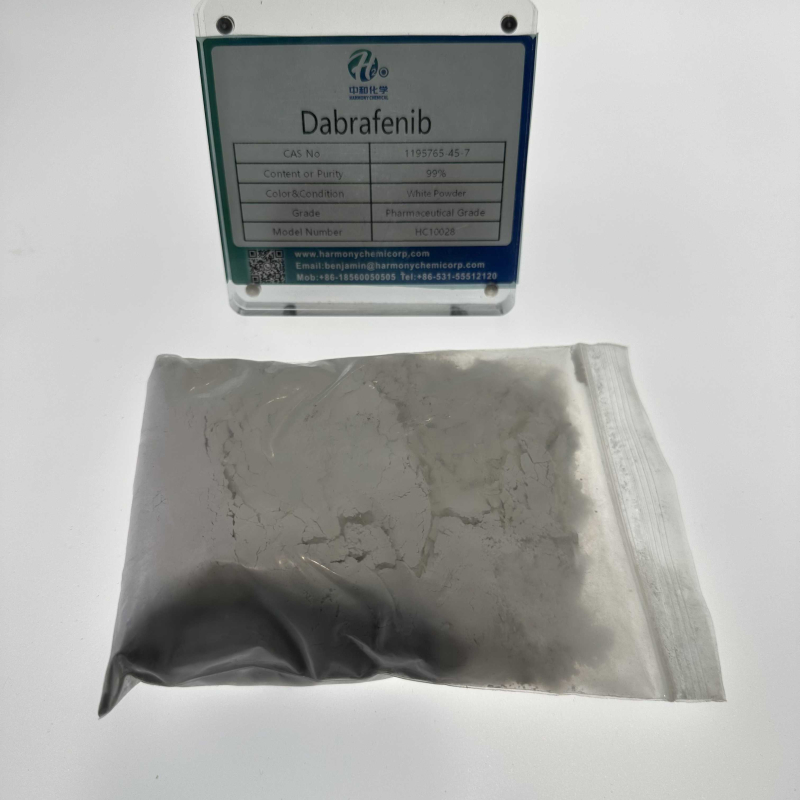nameMETHOPRENECAS NO40596-69-8Molecular formulaC19H34O3molecular weight310.47melting point<25℃boiling pointbp0.06 135-136°density0.9261 g/cm3 (20℃)Storage conditions0-6°CsolubilityChloroform (Slightly), Methanol (Sparingly)formneat
Contact Now
nameL-carnitineCAS NO541-15-1Molecular formulaC7H15NO3molecular weight161.2melting point197-212 °C(boiling point287.5°CStorage conditionsStore below +30°C.formCrystals or Crystalline PowdercolourWhitepH value6.5-8.5 (50g/l, H2O)
Contact Now
nameEntrectinibCAS NO1108743-60-7Molecular formulaC31H34F2N6O2molecular weight560.64boiling point717.5±60.0 °C(Predicted)density1.340±0.06 g/cm3(Predicted)Storage conditionsStore at -20°Csolubilityinsoluble in H2OAcidity coefficient (pKa)12.01±0.43(Predicted)formsolid
Contact Now
AppearanceAmber obvious liquidSolid content% ≥ 40.0Density (20 ℃)g/cm3 ≥ 1.20PH fee (1% aqueous solution)9.0-11.0Solubility15gPolyaspartic acid (PASP) belongs to a crew of polyamino acids. Polyaspartic acid is susceptible to breakage due to the motion of microorganisms, fungi, and different factors, ensuing in the degradation of environmentally pleasant ammonia, carbon dioxide, and water. Therefore, polyaspartic acid has a extensive vary of uses.
Contact Now
nameFlorfenicolCAS NO73231-34-2Molecular formulaC12H14Cl2FNO4Smolecular weight358.21melting point153 °CSpecific Rotation26 +17.9° (DMF)boiling point618℃Storage conditionsInert atmosphere,2-8°CformsolidcolourWhite to Off-White
Contact Now
nameDabrafenibCAS NO1195765-45-7Molecular formulaC23H20F3N5O2S2molecular weight519.56melting point214-216oCboiling point653.7±65.0 °C(Predicted)density1.443Storage conditions-20°CformWhite solid.colourOff-white
Contact Now
Nickel chloride can take part in the response as a moderate Lewis acid, catalyze the coupling reaction, and coordinate with metallic hydride as a lowering agent to take part in the selective discount reaction. As a moderate Lewis acid, nickel chloride can realise the regioselectivity rearrangement of dienols in alcohol water solution.
Contact Now
Manganese carbonate, additionally acknowledged as manganese carbonate, has the chemical components MnCo3. Molecular weight 114.95. White hexagonal crystal or rose purple crystal. Specific gravity 3.125. Difficult to dissolve in water, soluble in dilute acids. Decompose in boiling water. At a hundred ℃, it decomposes into carbon dioxide and manganese oxide, and above 330 ℃, it decomposes to launch carbon dioxide and carbon monoxide. Roasting in air produces manganese trioxide. Roasting in oxygen generates manganese trioxide.
Contact Now
Zirconium acetate (liquid), a colorless obvious liquid organized by way of the response of zirconium oxychloride and sodium carbonate. Widely used in industries such as medicine, cosmetics, electronics, ceramics, paint, glass, etc.Density1.279g/mLat25 ° CFormliquidWater solubility931g/Lat20 ℃InchiKeyMFFVROSEPLMJAP-UHFFFFAOYSA-JCAS datalibrary 7585-20-8 (CASDataBaseReference)EPA Chemical InformationAceticacid, Zirconiumsalt (1:?) (7585-20-8)
Contact Now
nameMebendazoleCAS NO31431-39-7Molecular formulaC16H13N3O3molecular weight295.29melting point288.5°Cboiling point436.98°Cdensity1.1952Storage conditionsSealed in dry,2-8°CformneatcolourWhite to Pale Beige
Contact Now
Epidural AdministrationofRopivacainehydrochloride monohydrate effectivelyblockneuroethicpain(bothmechanicalallodyniaandheathyperalgesia)withoutinductionfanalgesictoleranceandsignificantlydelaystheevelopment ofneuropathicpain producedbyperipheral nervenjury.Ropivacainehydrochloride inhibitionpressure-inducedincreasesinfiltrationcoefficient(Kf)withoutaffectingpulmonaryarterypressure (Ppa), Pulmonary capillary pressures(Ppc),andzonalcharacteristics(ZC).Ropivacaine hydrochloride monohydrate preventspressure-induced lungedemansociatedhyperpermeability yasevidencebymaintainingPaO2,lungwet-to-dryrati
Contact Now
Tetracaine hydrochloride is used for mucosal floor anesthesia, conduction anesthesia, epidural anesthesia, and subarachnoid anesthesia; Used for ophthalmic floor anesthesia, barring constricting blood vessels, detrimental corneal epithelium, and growing intraocular pressure.nameTetracaine hydrochlorideCAS NO136-47-0Molecular formulaC15H25ClN2O2melting point149°Cdensity1.1279 (rough estimateStorage conditions2-8°Csolubilityalcohol: solublesoluble 40 parts of solventformneatcolourWhite to Almost whiteSOLUBLESoluble in water at 50mg/ml
Contact Now
nameUrapidil hydrochlorideCAS NO64887-14-5Molecular formulaC20H30ClN5O3molecular weight423.94melting point156-1580CStorage conditionsKeep in dark place,Inert atmosphere,Room temperaturesolubilityH2O: solubleformsolidcolourwhiteSOLUBLESoluble to 50 mM in water
Contact Now
nameLinocaine hydrochlorideCAS NO6108-05-0Molecular formulaC14H25ClN2O2molecular weight288.82melting point75-79℃Storage conditions2-8°CsolubilityH2O: solubleformsolidcolourwhiteSOLUBLESoluble in water (50 mg/ml), chloroform, ethanol, and benzene. Insoluble in diethyl ether.
Contact Now
nameDapoxetine hydrochlorideCAS NO129938-20-1Molecular formulaC21H24ClNOmolecular weight341.88melting point175-1790CStorage conditionsroom tempformpowdercolourwhitesolubilityDMSO: ≥20mg/mL
Contact Now
nameLevamisole hydrochlorideCAS NO16595-80-5Molecular formulaC11H13ClN2Smolecular weight240.75melting point266-267 °Cflash point9℃Storage conditions2-8°Crefractivity-126 ° (C=1, H2O)formCrystalline PowdercolourWhite to almost white
Contact Now
nameEsmolol hydrochlorideCAS NO81161-17-3Molecular formulaC16H26ClNO4molecular weight331.83melting point48-50°Cdensity1.026Storage conditions−20°CsolubilityH2O: soluble12mg/mLformbuffered aqueous solutioncolourWhite to Off-White
Contact Now
namePramoxine hydrochlorideCAS NO637-58-1Molecular formulaC17H28ClNO3molecular weight329.86melting point181-183°Storage conditionsInert atmosphere,Room TemperaturesolubilityChloroform (Slightly), Methanol (Slightly)formneatcolourWhite to Off-White
Contact Now
nameAmitrazCAS NO33089-61-1Molecular formulaC19H23N3molecular weight293.41melting point86-87°Cboiling point425.25°C (rough estimate)density1.1280Storage conditionsSealed in dry,Store in freezer, under -20°CformPowder/SolidcolourWhite
Contact Now
nameUlipristal AcetateCAS NO126784-99-4Molecular formulaC30H37NO4molecular weight475.62melting point183-185 ºCboiling point640.1±55.0 °C(Predicted)density1.19Storage conditions-20°Cformpowdercolourwhite to beige
Contact Now
Melting Point2-4 °C (lit.)Boiling Point90 °C (lit.)Density1.069 g/mL at 25 °C (lit.)Vapor Density3.1 (vs air)Vapor Pressure18 mm Hg ( 21.1 °C)Refractivityn20/D 1.368(lit.)Flash PointStore below +30°C.Although phosgene has excessive reactivity, its fairly poisonous and corrosive byproducts pose significant environmental strain and will progressively be phased out; DMC has a comparable nuclear response response center.
Contact Now
nameAlbendazoleCAS NO54965-21-8Molecular formulaC12H15N3O2Smolecular weight265.33melting point208-210 °Cdensity1.2561Storage conditions2-8°CformneatcolourWhite to Off-WhiteSOLUBLE0.75mg/L(209 ºC)
Contact Now
Main purposeEthylene glycol dimethyl acrylate is frequently used in the plastic and rubber industries as a crosslinking agent for ethylene acrylic copolymers, ABS, acrylic sheets, pipes, glass fiber bolstered polyester, PVC, ion trade resins, smokeless powder encapsulation polymerization, glazing, etc. is additionally used as a polymer in copolymerization, which will increase hardness, warmness resistance, climate resistance, solvent resistance, and friction resistance.
Contact Now
nameAcetophenoneCAS NO98-86-2Molecular formulaC8H8Omolecular weight120.15melting point19-20 °Cboiling point202 °Cflash point180 °FStorage conditionsStore below +30°C.formLiquidcolourClear colorless to light yellow
Contact Now





























